Terminal Time Travel: An Examination of the TERMINATOR Timelines

“I’ll be back.”
Three little words (four, if you break up the contraction) were never more prescient; did Arnold realize just how many times he’d “be back?” Following the first Terminator in 1984, we saw the T-800 chassis return in 1991’s Terminator 2: Judgement Day, 2003’s Terminator 3: Rise of the Machines, 2009’s Terminator Salvation (well, his digitized face, at least) and, finally (so far), 2015’s Terminator Genisys, each movie having varying degrees of success, quality and continuity. The one thing that the series had going for it in every installment was a screwed up idea of time travel and how going back into one’s past could alter one’s future…er, present? Past?
**OBLIGATORY SPOILER ALERT FOR A 30+ YEAR-OLD FRANCHISE**
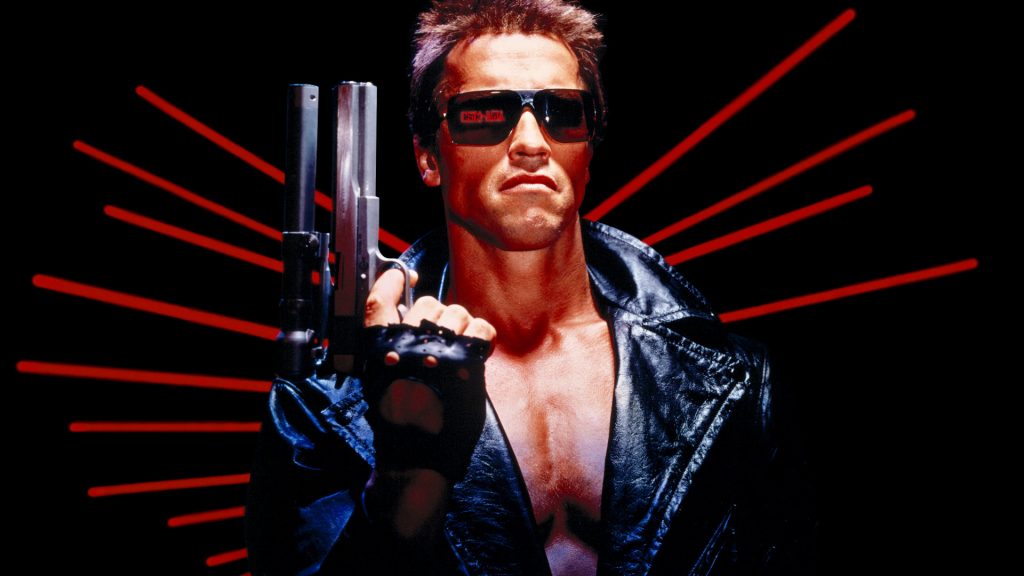
If you’re reading this (thanks!), you most likely already have at a passing knowledge of the premise of the Terminator movie universe. For those of you who don’t know of what I’m speaking of (did you click on the wrong link? If so, you can get to the home page here), the gist of the story is that the future is FUBAR due to robots taking over and they keep sending killer robots back into the past to take out a woman and, later, her son, the future leader of the human resistance. Hijinks ensue. I can’t speak to Genisys, as I haven’t seen it yet, but the four other movies range from “excellent” to “better than a poke in the eye with a sharp stick” (a colloquialism with which I have personal experience).
The quality of the series isn’t what I’m writing about today. No, this little essay is about the one thing that keeps me from completely enjoying the movies; a nit that I pick every time I see any of the films; a qualm that, if I entertain the thought in the middle of the night, will keep me awake for hours. This minor quibble is the fact that the whole “going back in time to take out your enemy (or your enemy’s mom)” doesn’t work. Or, it doesn’t unless you jump through a few hoops in order to make it work. Contrary to the way this sounds, I actually love talking about those hoops (and my wife loves it so much that she falls asleep if I start talking about it at bedtime).
Here’s where things might start to get a little science/sci-fi dense (if you’re already sleepy, you might want to get into a comfortable position on the couch or in bed, not so much so that you’ll already be in the right place to fall asleep while reading this article, but more so that you won’t hit your face on your keyboard if you nod off). Time itself is a manmade construct; it doesn’t really exist outside of our day-to-day comings and goings. Nature doesn’t run on a clock. The sun doesn’t come up every morning around 6am because it’s 6am; it’s 6am because the sun is coming up. The moon doesn’t change phases to fit within a month on the calendar; the month is dictated by the phases of the moon. Time is our way of making sense of the passage of life. Because we are not omniscient, we see time as being linear, with our perceived point in time being time’s furthest point and always moving forward, with the past inaccessible, except in memory.
As of right now (and as far as we know), time travel is not possible; if you subscribe to time being linear and that we are on the only timeline there is, then it may not be possible at all. In a linear timeline, if one could go back in time, one could wind up messing things up for us here in the present. In a time travel related version of the Butterfly Effect, if one were to go back and change the slightest thing, even just killing a simple housefly, that could cause a ripple effect, reaching all the way to the present (this was played to comedic effect in the Simpsons Treehouse of Horror episode, “Time and Punishment”). This change could result in the time machine/means of time travel never being created or discovered or even with the time traveler having never been born or born in a different time or place, resulting in the traveler having never made the jump to the past. Another hiccup that may make time travel infeasible is the oft referenced, pesky old Grandfather Paradox, wherein a person goes back in time and either intentionally or unintentionally kills their father’s father before the traveler’s father is born, resulting in the traveler not being born and, therefore, not travelling back in time to kill their grandfather. It’s as if time will find a way to correct itself; history may, indeed, be immutable.
 If time is linear, then the Terminator series fails right out of the gate. We take it for granted that the first movie is the first time that a T-800 is sent back in time to snuff out Sarah Connor, followed by Kyle Reese to protect Sarah. The way things (and people) are intertwined, though, it doesn’t work. In the movie, Reese tells Sarah about the future (his present) and about her son, John, the leader of the human resistance and the man who sent Reese back to protect his mother. We also find, later, after one of those “hey, we’re on the run from a murderous cyborg; let’s get it on!” situations, that Reese is John’s father, creating a problem; if this is the first time John sent Reese back in time, then who was John’s father beforehand? Reese was younger than John (in the future), meaning that Reese wasn’t even born in 1984, much less old enough to have had a relationship with Sarah, pre-Skynet apocalypse. If Reese is now John’s father, then the John Connor of the future (going from the then-present 1984) is not the same John Connor that sent Reese back, resulting in Reese never being sent back and then resulting in the ‘new’ John Connor having never been born.
If time is linear, then the Terminator series fails right out of the gate. We take it for granted that the first movie is the first time that a T-800 is sent back in time to snuff out Sarah Connor, followed by Kyle Reese to protect Sarah. The way things (and people) are intertwined, though, it doesn’t work. In the movie, Reese tells Sarah about the future (his present) and about her son, John, the leader of the human resistance and the man who sent Reese back to protect his mother. We also find, later, after one of those “hey, we’re on the run from a murderous cyborg; let’s get it on!” situations, that Reese is John’s father, creating a problem; if this is the first time John sent Reese back in time, then who was John’s father beforehand? Reese was younger than John (in the future), meaning that Reese wasn’t even born in 1984, much less old enough to have had a relationship with Sarah, pre-Skynet apocalypse. If Reese is now John’s father, then the John Connor of the future (going from the then-present 1984) is not the same John Connor that sent Reese back, resulting in Reese never being sent back and then resulting in the ‘new’ John Connor having never been born.
I think I just sprained my brain.
All of this to say, the linear time theory doesn’t work for the Terminator series.
There is another theory, though – the Many Worlds Interpretation. Simply put, in the MWI, it is posited that every decision that’s made results in a branching of the timeline. Suppose a man is in Timeline A and he has the choice to ask a woman out; as soon as the opportunity is presented, the timeline branches off – in this case, if he chooses to ask her out, the timeline branches off to Timeline B; if he chooses not to, then Timeline A continues on and he’s lonely. Because that choice was made available, though, there will now be two timelines, as both paths could’ve been taken. Taking it further, if the woman rejects the man’s offer, Timeline B will continue on (with a very sad, lonely man); if she accepts, though, there’s a new branch, Timeline C (with, hopefully, a very happy couple). These points, taking place not only with these two people, but with every decision made in the universe, would result in an infinite amount of parallel worlds. For the sake of keeping this article from being even longer than it’s likely to be, we’re only going to consider the major points in the movies, not every time someone decides to eat a bowl of Froot Loops instead of a bowl of Shredded Wheat or some other mundane thing like that.
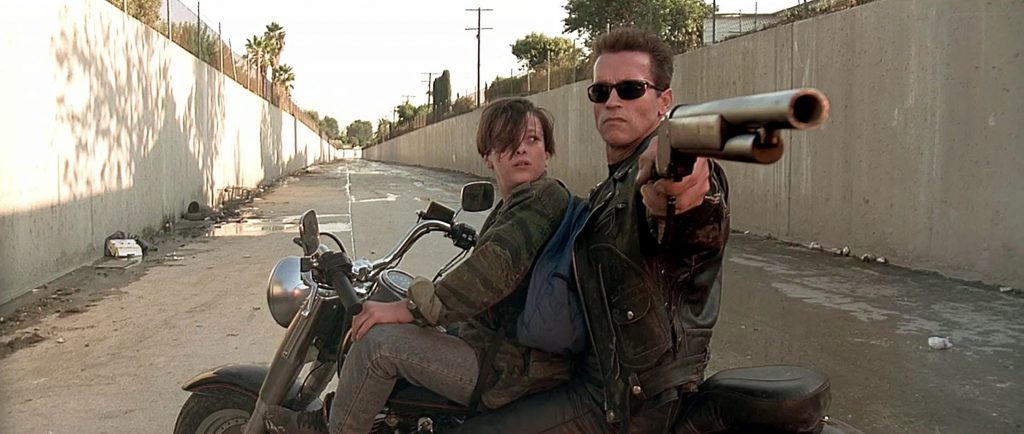
This hypothesis can make it so the premise of the franchise works. Going back to the first movie and again assuming this is the first time the events of the story unfold, we need to go back to the future (c’mon, you knew that I’d fit that in here somewhere), most specifically, John’s present (our future). From his vantage point, he’s on Timeline A; he knows that a T-800 has just been sent back in time (more precisely, back in Timeline A) and sends Reese back. This John Connor’s father was not Reese; we don’t know who his father was. All we know is that Sarah met him in 1984. Who knows? She may have married him and they had a happy life together until the apocalypse, when John was forced to learn to survive and become the hardened leader that he is in his relative present. None of that makes any difference now, as, with the arrival of the T-800 in 1984, a branch in the timeline has been created – Timeline B. Now, we have a timeline where Sarah is hunted and taken out by the Terminator. This has no effect on Timeline A John, but Timeline B now has no John Connor. Perhaps another leader rises up in his place; or, maybe, the Resistance never has a good leader and humanity is wiped out. Bummer.
All is not lost, though, for the arrival of Reese to 1984 causes a new branch in the timeline, Timeline C. This is the timeline that we see play out in the movie, where Reese becomes John’s father. This John Connor is different from the one that sent Reese from Timeline A; what’s he like? Is he the leader of the resistance and savior of the human race? Well, we don’t know right now; we find out in subsequent installments, though, that he is and does. We do know, though, that this timeline is what leads into Terminator: Judgement Day.
 The beginning of T2 is set in Timeline C. We see a rebellious tween John, who was taught a few things about how to take care of himself before his mom was locked up in an asylum. We also find that the events of the first movie, in addition to creating a new timeline branch, have also kind of accelerated the development of Skynet, with Cyberdyne using the microchip from the arm of the demolished T-800 from Terminator to create Skynet. This leads credence to the idea of the franchise happening in a Many Worlds universe, as Skynet couldn’t have been created using Terminator technology if time was linear.
The beginning of T2 is set in Timeline C. We see a rebellious tween John, who was taught a few things about how to take care of himself before his mom was locked up in an asylum. We also find that the events of the first movie, in addition to creating a new timeline branch, have also kind of accelerated the development of Skynet, with Cyberdyne using the microchip from the arm of the demolished T-800 from Terminator to create Skynet. This leads credence to the idea of the franchise happening in a Many Worlds universe, as Skynet couldn’t have been created using Terminator technology if time was linear.
Again, though, another timeline is created with the arrival of the T-1000, creating Timeline D, where the T-1000 finds and kills John, snuffing out any possibility of a Connor-led human resistance in that timeline. Timeline E is created, though, with the arrival of the reprogrammed ‘protector’ T-800; this is the timeline that the movie ends with. Timeline C continues on an unknown path, probably with John (Reese’s son) still becoming the Resistance leader (the apocalypse still happens, as Cyberdyne has the T-800 chip); Timeline D goes on with John killed by the T-1000 and, perhaps, someone else taking his place and Timeline E ends as we see unfold on the screen, leading to Terminator: Rise of the Machines.
Whew…

Before we get further into this rabbit hole, let’s recap:
Timeline A: No Terminators are sent to the past; Sarah Connor meets Mr. X and becomes pregnant with John, who becomes the human resistance leader after the eventual (and inevitable, apparently) nuclear holocaust on August 29, 1997.
Timeline B: The first T-800 is sent to 1984, finds Sarah before she meets Mr. X and kills her, resulting in a future with no John Connor as the resistance leader.
Timeline C: Reese is sent to 1984 by Timeline A John Connor. He becomes Timeline C John Connor’s father, meeting Sarah before she meets Mr. X.
Timeline D: The T-1000 is sent back to 1995 and finds and takes out 11 year-old Timeline C John Connor, resulting in a future with no John Connor as the Resistance leader; also, Skynet is created sooner by dint of the T-800’s technology becoming available in this timeline.
Timeline E: The ‘protector’ T-800 is sent back, saving John Connor, who becomes the 19 or 20 year-old John Connor in T3; Cyberdyne is destroyed, pushing back Skynet’s development.

I just realized, after writing all this out, that there would be timeline branches in the event of, say, Reese coming back, but failing to protect Sarah, with the T-800 ultimately taking her out. There’s no way I’m going back to change all the timelines in this thing, so, for the sake of making my life easier, consider the previously mentioned situation (and those like it) to be a sub-level of its timeline, with the John Connor of that timeline ceasing to be and not exist in the future of that timeline (i.e. Reese failing would be Timeline C-2 and the T-1000 defeating the T-800 and taking out Timeline E John would be Timeline E-2). That should be sufficiently confusing.
I need an aspirin…
 Hoookay – moving on to Terminator 3: Rise of the Machines. We’re now in 2003, which finds Timeline E John living off the grid in an attempt to avoid detection. The apocalypse still hasn’t happened, being pushed back a few years by the destruction of Cyberdyne in T2. Somehow, the world spanning, self-aware computer system Skynet didn’t have access to Google in the future and can’t find John, so it sends a new model Terminator, the T-X, a shapeshifting Terminator that stays pretty much in a female body form, to take out John’s top resistance lieutenants (before they became said lieutenants, of course). The arrival of the T-X creates Timeline F, where she successfully takes out her targets, including John and his future wife, Kate Brewster. Not surprisingly, another Terminator, this time a T-850, is sent back by the Resistance, creating Timeline G and takes out the T-X (Timeline G-2 would be created if the T-X had beaten the T-850). In Timeline G, the nuclear holocaust starts on July 24, 2003 and John begins his role as a leader. It’s also worth noting (I guess – I’m not sure I really care at this point) that the T-850 sent back was another reprogrammed model – reprogrammed after it’d killed Timeline G John in 2032.
Hoookay – moving on to Terminator 3: Rise of the Machines. We’re now in 2003, which finds Timeline E John living off the grid in an attempt to avoid detection. The apocalypse still hasn’t happened, being pushed back a few years by the destruction of Cyberdyne in T2. Somehow, the world spanning, self-aware computer system Skynet didn’t have access to Google in the future and can’t find John, so it sends a new model Terminator, the T-X, a shapeshifting Terminator that stays pretty much in a female body form, to take out John’s top resistance lieutenants (before they became said lieutenants, of course). The arrival of the T-X creates Timeline F, where she successfully takes out her targets, including John and his future wife, Kate Brewster. Not surprisingly, another Terminator, this time a T-850, is sent back by the Resistance, creating Timeline G and takes out the T-X (Timeline G-2 would be created if the T-X had beaten the T-850). In Timeline G, the nuclear holocaust starts on July 24, 2003 and John begins his role as a leader. It’s also worth noting (I guess – I’m not sure I really care at this point) that the T-850 sent back was another reprogrammed model – reprogrammed after it’d killed Timeline G John in 2032.
 Terminator Salvation continues on in Timeline G and stays there for most of the movie, as there’s no backward time travel occurring in this installment. Taking place in 2018, just before the T-800 series has been released, the Resistance is in full swing, but John has not yet become the leader of the organization that the previous movies have made him out to be; he still has a pretty strong following, as we find out later. He also is aware that Reese is his father, knowing that he will send Reese to the past at some point in the near future, having presumably been filled in on the details before his mom died (it was established in T3 that she’d died before that movie).
Terminator Salvation continues on in Timeline G and stays there for most of the movie, as there’s no backward time travel occurring in this installment. Taking place in 2018, just before the T-800 series has been released, the Resistance is in full swing, but John has not yet become the leader of the organization that the previous movies have made him out to be; he still has a pretty strong following, as we find out later. He also is aware that Reese is his father, knowing that he will send Reese to the past at some point in the near future, having presumably been filled in on the details before his mom died (it was established in T3 that she’d died before that movie).
At any rate (geez, this has turned out more convoluted than I thought it would – if you’re still reading, thanks!), we have another major point of divergence, when John is severely wounded and about to die. With a heart transplant provided by the cyborg protagonist Marcus Wright (long story – just go with it), John is provided with a second chance at life and the ability to go on to become the great leader he was destined to become, continuing on with Timeline G; Timeline H, naturally, branches off from the point where John dies and the Resistance is less its great leader. This means that the Reese that is sent and creates Timeline C is Timeline G Reese. I guess he’s Timeline G-C Reese in 1984.
I feel a nosebleed coming on…
This all leads up to Terminator Genisys. As I said what seems to be so long ago, I’ve not seen it, so I had to read an overview of the movie and its setting.
My head nearly popped.
 OK, it seems that this takes place when Timeline G John sends Timeline G Reese back to 1984, ostensibly taking us back to the setting for the first movie. When Reese reaches 1984, though, it’s no longer Timeline C; apparently, at some point in the future, ANOTHER T-800 was sent back to 1973 to serve as a guardian for 9 year-old Sarah (what happened to her parents, I don’t know), creating Timeline I, making this version of Reese Timeline G-I Reese. The Sarah in this new timeline has her own time machine and plans to use it to go to 1997 in order to stop Skynet from becoming self-aware. We find, through some time travel shenanigans that are revealed later, that Reese knows that Skynet (Genisys) in this timeline won’t become active until August 28, 2017 and they travel to that year instead. Time travelling to 2017 instead of 1997 (and just deciding to travel at all) causes a few branches now (gah – why did I decide to do this?):
OK, it seems that this takes place when Timeline G John sends Timeline G Reese back to 1984, ostensibly taking us back to the setting for the first movie. When Reese reaches 1984, though, it’s no longer Timeline C; apparently, at some point in the future, ANOTHER T-800 was sent back to 1973 to serve as a guardian for 9 year-old Sarah (what happened to her parents, I don’t know), creating Timeline I, making this version of Reese Timeline G-I Reese. The Sarah in this new timeline has her own time machine and plans to use it to go to 1997 in order to stop Skynet from becoming self-aware. We find, through some time travel shenanigans that are revealed later, that Reese knows that Skynet (Genisys) in this timeline won’t become active until August 28, 2017 and they travel to that year instead. Time travelling to 2017 instead of 1997 (and just deciding to travel at all) causes a few branches now (gah – why did I decide to do this?):
Timeline I: Do nothing and everything’s hunky dory until August 2017.
Timeline J: Go to 1997 and find that Skynet’s not ready yet, so…nothing happens.
Timeline K: Go to 2017 and stop Skynet (Genisys), the timeline that the movie follows (Timeline K-2 branching off if they fail) and which, if someone makes another entry in the franchise, and if they continue on as a direct sequel to Genisys, will be the timeline that the movie will take place in.
This would make Reese Timeline G-I-K Reese.
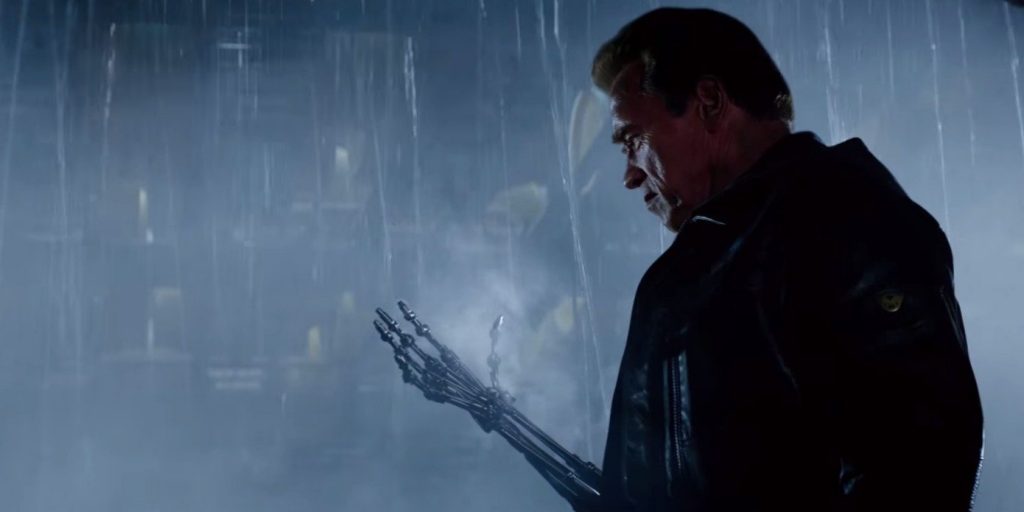
Seriously, my head hurts.
So, there you have it; a long, convoluted walk through the Terminator movie franchise timelines (I’m not even going to touch The Sarah Connor Chronicles and how it fits in; some other masochist can take on that one). If you’ve slogged through this whole thing, well…thank you?
Now do you understand why this topic keeps me awake at night (and puts my wife to sleep)?
![]()

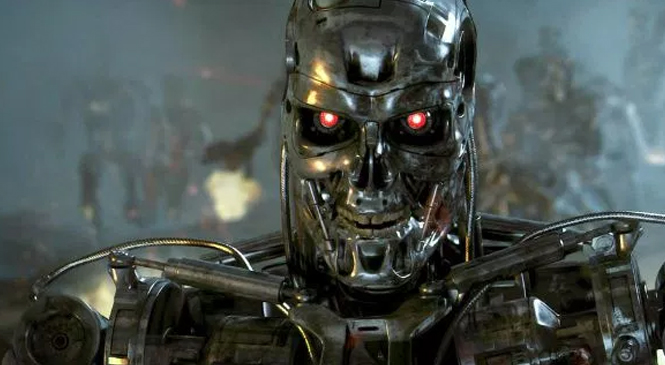

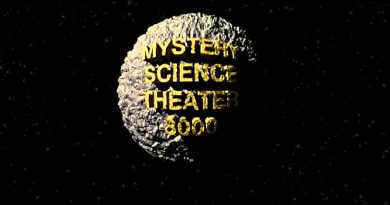
I’m going to have a really big drink right now, and then re-read this for fun. Good grief!
It nearly drove me to drink writing it 😀